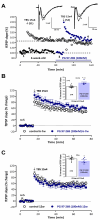Postweaning Development Influences Endogenous VPAC1 Modulation of LTP Induced by Theta-Burst Stimulation: A Link to Maturation of the Hippocampal GABAergic System
- PMID: 38540797
- PMCID: PMC10968312
- DOI: 10.3390/biom14030379
Postweaning Development Influences Endogenous VPAC1 Modulation of LTP Induced by Theta-Burst Stimulation: A Link to Maturation of the Hippocampal GABAergic System
Abstract
Long-term potentiation (LTP) induced by theta-burst stimulation (TBS) undergoes postweaning developmental changes partially linked to GABAergic circuit maturation. Endogenous vasoactive intestinal peptide (VIP) acting on its VPAC1 receptor strongly influences LTP induced by theta-burst stimulation (TBS), an effect dependent on GABAergic transmission. Although VPAC1 receptor levels are developmentally regulated during embryogenesis, their variation along postweaning development is unknown, as is the VPAC1 modulation of LTP or its relation to hippocampal GABAergic circuit maturation. As such, we investigated how VPAC1 modulation of LTP adjusts from weaning to adulthood along with GABAergic circuit maturation. As described, LTP induced by mild TBS (5 bursts, 4 pulses delivered at 100 Hz) was increasingly greater from weaning to adulthood. The influence of the VPAC1 receptor antagonist PG 97-269 (100 nM) on TBS-induced LTP was much larger in juvenile (3-week-old) than in young adult (6-7-week-old) or adult (12-week-old) rats. This effect was not associated with a developmental decrease in synaptic VPAC1 receptor levels. However, an increase in pre and post-synaptic GABAergic synaptic markers suggests an increase in the number of GABAergic synaptic contacts that is more prominent than the one observed in glutamatergic connections during this period. Conversely, endogenous VPAC2 receptor activation did not significantly influence TBS-induced LTP. VPAC2 receptor levels enhance pronouncedly during postweaning development, but not at synaptic sites. Given the involvement of VIP interneurons in several aspects of hippocampal-dependent learning, neurodevelopmental disorders, and epilepsy, this could provide important insights into the role of VIP modulation of hippocampal synaptic plasticity during normal and altered brain development potentially contributing to epileptogenesis.
Keywords: PSD-95; VGAT; VGlut1; VIP; VPAC1 receptor; gephyrin; hippocampus; theta-burst LTP.
Conflict of interest statement
The authors have no conflicts of interest in the publication of this paper.
Figures






Similar articles
-
Endogenous VIP VPAC1 Receptor Activation Modulates Hippocampal Theta Burst Induced LTP: Transduction Pathways and GABAergic Mechanisms.Biology (Basel). 2022 Apr 20;11(5):627. doi: 10.3390/biology11050627. Biology (Basel). 2022. PMID: 35625355 Free PMC article.
-
Mismatch novelty exploration training shifts VPAC1 receptor-mediated modulation of hippocampal synaptic plasticity by endogenous VIP in male rats.J Neurosci Res. 2024 Apr;102(4):e25333. doi: 10.1002/jnr.25333. J Neurosci Res. 2024. PMID: 38656542
-
Endogenous inhibition of hippocampal LTD and depotentiation by vasoactive intestinal peptide VPAC1 receptors.Hippocampus. 2014 Nov;24(11):1353-63. doi: 10.1002/hipo.22316. Epub 2014 Jul 7. Hippocampus. 2014. PMID: 24935659
-
VIP Modulation of Hippocampal Synaptic Plasticity: A Role for VIP Receptors as Therapeutic Targets in Cognitive Decline and Mesial Temporal Lobe Epilepsy.Front Cell Neurosci. 2020 Jun 12;14:153. doi: 10.3389/fncel.2020.00153. eCollection 2020. Front Cell Neurosci. 2020. PMID: 32595454 Free PMC article. Review.
-
VIPergic neuroprotection in epileptogenesis: challenges and opportunities.Pharmacol Res. 2021 Feb;164:105356. doi: 10.1016/j.phrs.2020.105356. Epub 2020 Dec 15. Pharmacol Res. 2021. PMID: 33338622 Review.
References
MeSH terms
Grants and funding
- UIDB/04046/2020 (DOI: 10.54499/UIDB/04046/2020)/Fundação para a Ciência e Tecnologia
- UIDP/04046/2020 (DOI: 10.54499/UIDP/04046/2020)/Fundação para a Ciência e Tecnologia
- Norma Transitória - DL57/2016/CP1479/CT0044 to DCR (DOI: 10.54499/DL57/2016/CP1479/CT0044)/Fundação para a Ciência e Tecnologia
- FCT/POCTI (PTDC/SAUPUB/28311/2017) EPIRaft grant/Fundação para a Ciência e Tecnologia
- SFRH/BPD/81358/2011 to DCR/Fundação para a Ciência e Tecnologia
LinkOut - more resources
Full Text Sources
Research Materials

